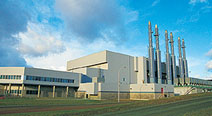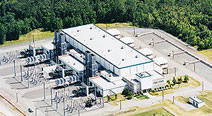Fossil Fuels

Since they burn fossil fuels, thermal power plants cost more to operate and emit more pollutants in comparison to hydroelectric generating stations.
While these facilities represent only a small portion of Hydro-Québec's overall generating capacity, they play a vital role in meeting Québec's baseload and peak energy requirements. They're also useful in supplying power to remote, off-grid regions such as the Îles-de-la-Madeleine.
Thermal Generation at Hydro-Québec
Some thermal power stations operate continuously to meet baseload energy needs; for instance, diesel plants generating stations. The gas-fired facility, Bécancour operates only when demand is high and hydroelectric facilities are working at maximum capacity.
Diesel
 Îles-de-la-Madeleine generating station
Îles-de-la-Madeleine generating station
Diesel-powered stations are used mainly in remote areas. For the most part, they supply electricity to isolated communities in Nunavik, the Basse-Côte-Nord and in the Haute-Mauricie region. Diesel plants power off-grid systems. The facility shown in the photo is Hydro-Québec's largest diesel-fired generating station, located in the Îles-de-la-Madeleine.

Ce type de centrale ne comporte pas de turbine ; l'énergie mécanique créée par le moteur diesel (A) entraîne directement l'alternateur (B).
Light oil and natural gas
 Bécancour generating station
Bécancour generating station
Gas-turbine generating stations generally burn light oil or natural gas. They are called "gas-turbine" because their combustion process produces gas that drives the turbine. Given the relatively high cost of fuel needed to run these facilities, they are used only during periods of peak demand. These generating stations have the advantage of taking only minutes to start and stop operations, compared to the longer time frames required by other thermal power stations.

L'alternateur (A) d'une centrale à turbines à gaz est entraîné par une turbine (B) constituée d'une roue à ailettes. C'est la poussée exercée sur les ailettes par la détente d'un mélange gazeux (C) qui fait tourner la turbine. On obtient le mélange gazeux en faisant brûler du mazout léger (D) en présence d'air comprimé.

